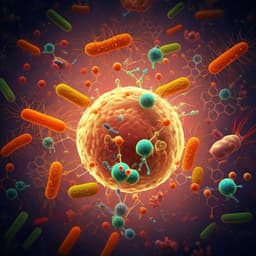
Veterinary Science
Environmental remodeling of human gut microbiota and antibiotic resistome in livestock farms
J. Sun, X. Liao, et al.
This groundbreaking study reveals how exposure to swine farm environments can significantly alter the gut microbiome and resistome of veterinary students over a span of three months. The research led by Jian Sun, Xiao-Ping Liao, and their esteemed colleagues uncovers the potential for pathogenic bacteria and antibiotic resistance to thrive in human gut profiles post-exposure, highlighting a pressing issue in environmental health.
~3 min • Beginner • English
Introduction
The study investigates how short-term exposure to a high-risk agricultural environment (swine farms with prevalent antibiotic use) remodels the human gut microbiota and antibiotic resistome. Prior work shows the gut microbiota is generally stable yet responsive to environmental perturbations, with environment often outweighing host genetics in shaping composition. Swine farms are hotspots for enrichment and exchange of antibiotic-resistant bacteria and resistance genes due to routine antibiotic administration. The authors hypothesize that temporary environmental conversion to a swine farm setting will shift students’ gut community and resistome toward farm-associated profiles, including potential acquisition of pathogenic taxa and mobile antibiotic resistance genes, and examine recovery after returning to a non-farm environment.
Literature Review
Background literature highlights: human gut microbiota stability and resilience with noted responsiveness to diet, geography, and drugs; environment dominates host genetics in shaping gut communities. Swine farms, where antibiotics are widely used, serve as reservoirs and hotspots for resistance gene enrichment and exchange, with documented cases like plasmid-borne colistin resistance mcr-1 first emerging in Chinese swine farms. Transmission routes to humans include contaminated meat, dust, manure, and wastewater. Previous studies document environmental transmission of antibiotic resistance among livestock and humans and emphasize the need to quantify disruption of human microbiota and distribution/enrichment of resistance genes from such environments to assess public health risk.
Methodology
Study design: 14 healthy male veterinary students undertook 3-month internships at three large-scale swine farms in China (Henan, Jiangxi, Guangdong). Fecal samples were collected longitudinally at seven time points: T0 (1–2 weeks pre-exposure), T1–T3 (during farm stay, weekly), and T4–T6 (post-return, monthly for 3 months). Fecal samples from 4–5 farm workers per farm were collected monthly during student stays. Environmental samples (per farm, monthly during student stay) comprised pig feces (∼40), soil (3), sewage (3), and ventilation dust (3); subsets were pooled for metagenomics.
Sequencing and analyses: 16S rRNA gene (V3–V4) sequencing on 91 student fecal samples characterized taxonomic dynamics; processing via QIIME2 with DADA2, MAFFT, FastTree; alpha/beta diversity by Shannon and UniFrac; community analyses by PCoA/dbRDA and PERMANOVA. Whole-metagenome shotgun sequencing (Illumina HiSeq 3000, 150 bp PE) on 42 student fecal samples (T0, T3, T6) and nine worker fecal samples; and pooled environmental WGS from 12 samples (pig feces, soil, sewage, dust). Reads QC with FASTX; host DNA removal with SOAPaligner.
Assembly and gene catalog: Assembled with MEGAHIT (and SOAPdenovo comparison); gene prediction by MetaGeneMark; non-redundant catalogs built with CD-HIT. Taxonomic profiling via MetaPhlAn2.
Resistome and functional profiling: AR genes identified by BLASTP to CARD (stringent >95% identity and coverage) and Resfams core, yielding 12,739 unique AR genes; combined with CARD to build ShortBRED markers (20,514 markers for 5607 families), curated to exclude non-specific determinants, resulting in 1924 AR gene families for quantification (RPKM). Virulence factors (VFDB) and biocide/metal resistance genes (BacMet) annotated by BLASTP (>80% identity, >70% coverage). Mobile genetic elements (MGEs) annotated via Pfam and KEGG; AR-MGE co-localization inferred when within 10 kb on same contig. Contig taxonomy assigned by BLASTN against NCBI microbial genomes.
Transmission inference: SourceTracker used to estimate source contributions of newly observed genes/species in student samples from environmental reservoirs and workers. Species-level transmission events required probability >80%, sufficient gene counts (>100) and abundance (>0.01%). High-abundance species genomes reconstructed from metagenomes by mapping to references, de novo assembly (Velvet), scaffolding (SSPACE), gap filling (GapFiller), and ANI computation.
Culture-based assays: From all samples, 1851 E. coli isolates collected (students 954; workers 182; pigs 657; environment 58). A subset of 82 E. coli isolates (one farm) underwent PFGE to assess clonal relatedness. Antimicrobial susceptibility testing by agar dilution per CLSI M100-S25 to 11 drugs (CS, CTX, GEN, AMK, TET, FOS, CIP, S/T, CHL, MEM, TIG). PCR screening for blaCTX-M and fosA3; PCR mapping to assess genetic contexts and co-localization structures.
Time-series modeling: Dynamic Bayesian network (DBN) based on 16S genus-level profiles (39 high-abundance genera across 12 students with sufficient data). Associations inferred with eLSA (P<0.01), model equations learned via Eureqa; cross-validated predictions; extrapolated compositions projected for T7–T9 to estimate reversion timelines.
Statistics: PERMANOVA (adonis, Bray–Curtis, 999 permutations), dbRDA (vegan), Procrustes (vegan protest), multiple testing by Benjamini–Hochberg.
Key Findings
- Microbiota shift with exposure: 16S-based PERMANOVA showed significant temporal change in students’ gut communities over farm exposure (R2=7.4%, P<0.001), with detectable shift within 1 month (T1) and partial reversion by T6. Alpha diversity (observed OTUs, Shannon index) did not significantly change (q>0.05). Taxonomic shifts included decreased Bacteroidetes and increased Proteobacteria (notably Gammaproteobacteria), with changes in Faecalibacterium, Collinsella, Blautia, and Veillonellaceae.
- Convergence toward worker profiles: WGS dbRDA indicated students’ T3 microbiomes diverged from T0 and resembled farm workers; T3 was more dissimilar from an external healthy urban Chinese cohort than T0 or T6. Bray–Curtis dissimilarity between T0 and T3 exceeded that between T0 and T6.
- Resistome dynamics: Identified 1924 non-redundant AR gene families; resistome composition correlated with microbiome structure (Procrustes P<0.001). No significant change in total AR gene counts/abundance during farm stay, but average 3.7% increase in relative abundance (RPKM) and increases in specific mechanisms (e.g., subclass B3 β-lactamases, aminoglycoside acetyltransferases, tetracycline ribosomal protection proteins).
- Environmental acquisition: Upon farm arrival, student samples showed an average 42% increase (range 18–61%) in newly observed genes, ~two-thirds also present in farm environmental microbiomes. SourceTracker identified 142 species transmission events from farm environments (mainly swine feces and soil) into students’ guts, including taxa with pathogenic strains (e.g., Ruminococcus spp., Escherichia spp., Pseudomonas putida). Reconstructed genomes from students and environments showed near-clonal identity (16S similarity ~99.9%, ANI ~99.5%). Culture-based PFGE documented clonal E. coli spread among students, workers, and environment.
- Clinically relevant cargo: About 27% of transmitted species carried at least one AR gene on contigs; 30% carried virulence factors; 18% each carried biocide and heavy metal resistance genes. In student resistomes during farm stay, 25% (477/1924) of AR genes co-localized with MGEs. SourceTracker inferred 270 AR genes transferred from environments to students, with swine feces and sewage as major sources.
- Key AR genes: Identified 120 medically important AR genes (e.g., blaTEM, blaCTX-M, qnrS, tet(X)) enriched during/after farm stays; 41% (49/120) shared similar genetic contexts between human and environmental contigs, frequently MGE-associated (e.g., blaCTX-M synteny shared). Phenotypically, among 1851 E. coli isolates, resistance rates to nine antibiotics (including cefotaxime, ciprofloxacin, fosfomycin) increased at T1–T3 vs T0 and remained high at T4–T6. Detection rates of plasmid-mediated blaCTX-M and fosA3 increased during T2–T4 then declined by T6; co-localization of fosA3 with blaCTX-M-14 on an identical IS903–fosA3–IS26 genetic structure was found across students, pigs, and soil isolates.
- Recovery trajectory: DBN modeling predicted that gut microbiota composition would likely revert toward baseline within 4–6 months post-exposure, stabilizing by 6–9 months. Resistome showed partial reversion, but some clinically relevant AR genes persisted beyond 3 months post-return.
Discussion
The findings demonstrate that short-term occupational exposure to swine farm environments can remodel human gut microbiota and resistomes, shifting student profiles toward those of farm workers and facilitating extensive exchange of bacteria (including potential pathogens) and mobile resistance genes from environmental reservoirs. The observed congruence between microbiome and resistome changes, the clonal linkage between student and environmental strains, and shared genetic contexts of critical AR genes implicate both microbial transmission and horizontal gene transfer as mechanisms. Though overall alpha diversity remained stable and community composition partially reverted after leaving the farm, resistome features (including important plasmid-mediated determinants) persisted, suggesting potential sustained clinical risk. These results underscore environmental connectivity as a determinant of human gut ecology and highlight occupational agriculture as a vector for AR dissemination to human commensals.
Conclusion
This study provides longitudinal, multi-omic, and culture-based evidence that temporary residence and work in swine farm environments reshapes the human gut microbiota and enriches the antibiotic resistome, with detectable acquisition of environmental species and AR genes, including clinically important, MGE-associated determinants. Community structure partially reverts within months after exposure ends, but some AR features persist. The work emphasizes the need for surveillance and mitigation strategies in agricultural settings and supports building quantitative risk models for AR transmission. Future research should expand cohorts (including control groups and both sexes), prolong follow-up to assess long-term resistome persistence, dissect specific environmental drivers (diet, stressors, specific reservoirs), and mechanistically resolve pathways of horizontal gene transfer between environmental and human-associated microbes.
Limitations
Key limitations include small sample size (n=14) limited to male students, lack of a parallel unexposed control group, potential confounding factors due to lifestyle changes during farm residence (diet, stress, hygiene, antibiotic use) that accompany environmental exposure, and finite environmental sampling that may underrepresent true reservoir diversity. Follow-up duration may be insufficient to fully capture long-term resistome persistence. Causality between specific environmental factors and observed changes cannot be definitively assigned.
Related Publications
Explore these studies to deepen your understanding of the subject.







